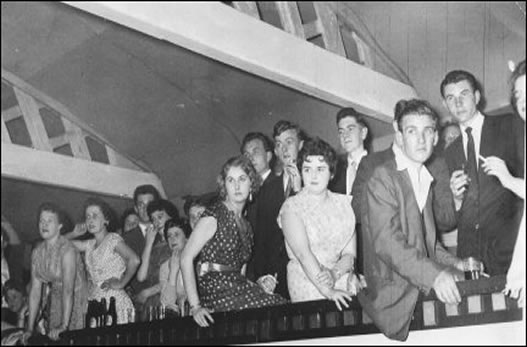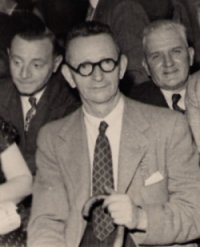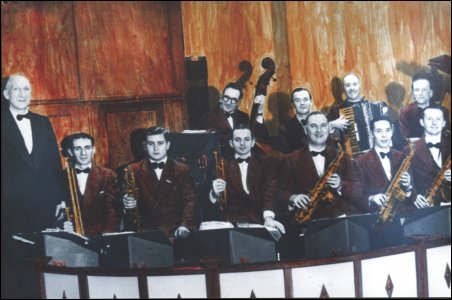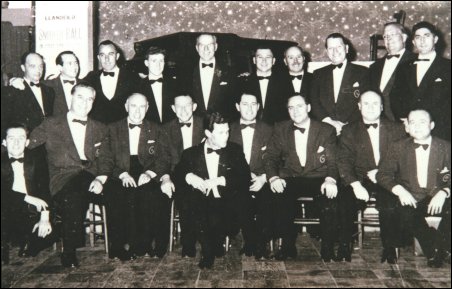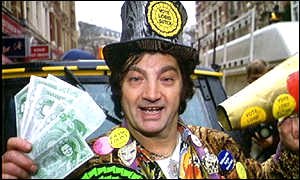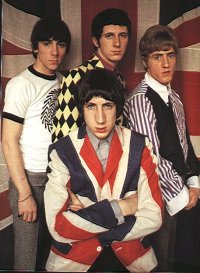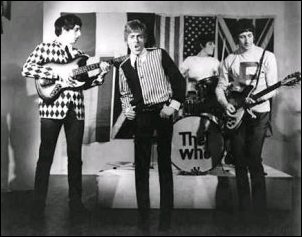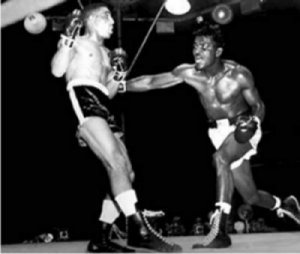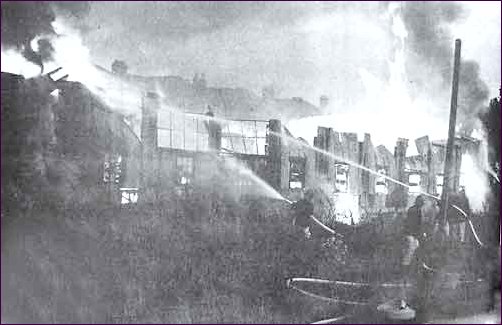CONTENTS 1 The Beginnings 2 The Sixties 3 Wrestling comes to the Regal 4 Fire ends an era 5 End Note 1. The Beginnings
The year was 1948 and the conversation might have gone something like this:
"Run that past us again, would you?"
"Well; you know the old bus garage by Tirydail station is empty since Western Welsh moved to their new place?"
"You mean that corrugated iron shed with a dirt floor and an open stream running through the building."
"That's the one."
"What exactly did you have in mind, again?"
"Well, I'm going to turn it into a deluxe dance hall and roller skating rink. What do you think?"
Silence, followed by unsurpressed giggling.
"Even though you don't have a licence from the government for building materials, which you can't get anyway, because non-essential work like dance halls doesn't qualify?"
"That's right."
Pause.
"Are you sure you took your tablets before coming out this morning?"
This conversation may be imaginary but it's surely what people must have thought when this budding entrepreneur unveiled his grand scheme on an unsuspecting Ammanford. In 1948, the Western Welsh Omnibus Company moved from their old garages in Station Road to custom-designed premises in Tirydail Lane, leaving behind a derelict plot with no obvious use at the time. Until, that is, the entrepreneurial instincts of a local man saw that industrial development wasn't the only option for the site, and made a decision that would soon usher in a new era in Ammanford's entertainment history. Mr. William Ewart Parry and his sons (by trade, master painters and decorators), saw a potential in the vacated property, tucked away behind a block of flats, and they soon acquired planning permission from the local authority to convert the old building into a dance hall and skating rink.
This aerial photograph taken on 24/6/1964 shows a somewhat un-prepossessing Regal Ballroom behind the Tirydail Lane houses. Only three years later the Regal would be destroyed in a major fire. They must have been aware of considerable risks in this venture, considering the general structural condition of the building, which was just a timber-framed shell, clad in corrugated iron sheeting. If this wasn't bad enough, the premises had only a dirt floor with an open brook running inside for the full length of the building, not what can be described as ideal conditions to work on. Those acquainted with the premises were all somewhat skeptical of Mr. Parry's intentions and no wonder. One unusual feature of the building was the 'Belfast' type of roof trusses, these being formed on a principle of an arch or bowstring, strengthened with lattice bars, the type of truss usually found in factories or temporary buildings.
Revellers on the balcony of the Regal gazing rapturously at something or other, a fight perhaps. The 'Belfast' type roof trusses are clearly visible.. [Photo provided by Phillip Davies, grandson of the Regal's founder. Date unknown but probably early Sixties.] Also, after the devastation of the war period, building materials were in short supply and items such as timber, bricks and cement could only be obtained with a licence issued through the Ministry of Works. Even though the local council was fully supportive of the venture, it appeared that a dance hall and skating rink didn't rank high on the government's list of priorities and by September 1950 the promoters were still struggling to obtain their all-important licence.
William Ewart Parry (centre) founder of Ammanford's Regal ballroom. (Photo provided by Mr Phillip Davies)
Necessity is often the mother of invention, however, and the bulk purchase of a large consignment of disregarded timber ammunition boxes saved the day. When these boxes were stripped down and the end sections laid to form a pattern, a new floor miraculously materialized.
When the conversion was completed, the Regal Ballroom, with a capacity for eight hundred dancers, was officially opened on the 16th of April 1951 in all its full glory. ('Glory' is a relative term, of course; what is considered glorious in Ammanford may not live up to that description elsewhere.) The opening event was a dance organised by the Ammanford Police, sponsored by the Ammanford Urban District Council, as part of the local Festival of Britain celebrations. A capacity crowd turned the event into a phenomenal success, all entertained provided by Roy Desmond and his Regal Ballroom Orchestra who were to become the resident dance band for some years to come.
The Roy Desmond orchestra took its name from the sons of the co-founders: Gwynfi Phillips, whose son's middle name was Roy, and Jack "Sax" Davies, whose son's name was Desmond. Hence, Roy Desmond. (In later years the 'Roy' in question, better known by his first name of John Phillips, became a well known jazz pianist and composer.) Howard Moses in the photo below, 4th from the right in the front row, was killed at Pantyffynnon colliery just after this photo was taken, showing the class composition of the orchestra, who were mostly local miners. (I am grateful for this information to the late Ivor Davies of Myddynfych, former trumpet player in the band. Ivor Davies is 4th right, front row, in the band photograph below.)
Roy Desmond and his Regal Ballroom Orchestra in 1950 when they were the resident band at the Drill Hall. They became the resident band at the Regal from its opening in 1951: Back Row: Teifion Richards, Bryn Hitchins, Eddie Howells, Ted Griffiths. Front Row: Fred Jenkins MC (standing), Glan Jones, Ivor Davies, Howard Moses, Jack Davies (Jack "Sax"), Des Davies (son of Jack Sax), Harry Bevan. [Photo provided by Ivor Davies of Ammanford.]
The leading dance band of that era was Victor Sylvester's Ballroom Orchestra and they played the Regal in the fifties. Below is a joint photograph of the Victor Sylvester and Roy Desmond orchestras on that occasion:
The combined forces of Roy Desmond orchestra (standing at the back of the photo) and The Victor Sylvester orchestra (members seated at the front). Victor Sylvester himself is standing 5th from the left at the back (photo provided by Ivor Davies of Ammanford)
For a few years, at least, the genteel sounds of the fox trot, the quick step, the waltz and the hokey-cokey drifted on the late night air, as revellers stepped out on a floor made of wooden boxes that once contained artifacts of mass destruction. Not quite what the Old Testament author had in mind when he prophesied "they shall beat their swords into ploughshares and their spears into pruning hooks" (Micah, chapter 4, verse 3), but close enough.
The ballroom went on to be used for other entertainments, such as concerts, cultural events, exhibitions, dog shows, boxing promotions, all-in wrestling, and roller skating.
In June 1953, Mr Hubert Davies of Betws (who had held an appointment in Germany after the War as a Youth Welfare Officer), as a good will gesture between the two nations, organized the visit of a party of boys from Kohlsheid, West Germany, to take part in an amateur boxing tournament with local clubs, and the Regal was often used for amateur boxing tournaments thereafter. But In February 1962 the property was sold to Scott's Entertainments of Llanelli, and subsequently to a Swansea company, Flat Hire Ltd. The new companies continued to operate the Ballroom for dances, lettings and promotions, but with the local interest of the management now lost, the atmosphere was somehow lost with it.
1 The Beginnings 2 The Sixties 3 Wrestling comes to the Regal 4 Fire ends an era 5 End Note 2. The Sixties
"In Ammanford, dancing was a contact sport ..."
When the Regal was destroyed by a fire in 1967, an eye-witness to the conflagration hinted that not all was sweetness and light within its walls: "It looked like the last stand at the Alamo. An apt name for what went on in there at times. Great days. What memories." (South Wales Guardian, 14th September 1967.) What memories, indeed, but not everyone mourned the loss of the Regal Ballroom as he did. There had been occasional complaints from nearby residents about the noise created by the dance bands and later the rock bands, and the revellers themselves were not always models of behaviour as they made their less than decorous way home after the dances finished.As the Fifties drifted into the Sixties, the music fashions changed along with the years; the dance bands gave way to rock and roll which in turn gave way to the rock bands. Dance bands such as the Victor Sylvester and Joe Loss orchestras were the big names that packed the Regal in of he Fifties. The singers that Ammanford's revellers wanted to hear in that decade were the likes of Lita Rosa, Ronnie Carroll and Frankie Vaughan, and they all played the Regal in the 1950s. The Parry family of Ammanford sold the Regal in 1962, just as the so-called Swinging Sixties were emerging, and the new owners were well placed to take advantage of the new spirit of hedonism which that decade soon became synonymous with. During the period of the Beatles and their contemporaries, most of the major pop groups played the Regal. Manfred Mann, the Who, the Kinks, the Yardbirds, The Swinging Blue Jeans, Johnny Kidd and the Pirates and many others are all still remembered. The Who only had one hit at the time they played the Regal and they were booked on a Tuesday night, with the result that only about 20 people were there to see them.
Screaming Lord Sutch (1941–1999) was Britain's longest serving party leader as head of the Monster Raving Lunatic Party from 1963 until his death in 1999. He performed at the Regal, Ammanford, in the 1960s. Screaming Lord Sutch and his band made an appearance at the Regal and a local Labour Party dignitary and mayor of Ammanford is remembered for trying to get him to join the Labour Party on that occasion. Screaming Lord Sutch went on to form the Monster Raving Lunatic Party in 1963, and stood in almost forty elections of one sort or another, so perhaps he felt the Labour Party wasn't quite important enough for him. One of his policies was to abolish January and February to make winter shorter, which has a kind of logic to it. Pity no one else thought so, and there was never the slightest danger of his being elected. He did once, though, poll more votes at a by-election than the mainstream Social Democrats, prompting them to abolish themselves as a result, so he achieved something worthwhile. In 1999, aged 58, he hanged himself with a multi-coloured skipping rope in a fit of depression. His earlier visit to the Regal is not thought to have been a contributory factor.
'The Who' at the Regal
What the bands who performed at the Regal made of the audiences went unrecorded until recently. The ballroom gained quite a reputation for boisterousness, and many a Saturday consisted of an evening of fighting during which occasional bouts of dancing broke out spontaneously. Novel use was made of the balcony as a shortcut to the dance floor below, and whenever a fight erupted would-be participants could often be seen leaping fearlessly down to join the mayhem.On the night in 1964 that the Sixties' pop group The Who played the Regal, the supporting act was Swansea band 'The Jets'. One member of 'The Jets', Llanelli-born Deke Leonard, later wrote an autobiography, entitled "Maybe I should've stayed in bed?" which includes his memory of that night. Judging by his recollections perhaps he even took the book's title from the night in question:
The Who, looking a little apprehensive, and no wonder "One of the first gigs I did with The Jets was at the Regal, Ammanford, supporting The Who, who had just become flavour of the month – in London, that is. In Ammanford, where the citizenry were only interested in alcohol and violence, visiting musicians, be they famous or obscure, were regarded as merely the latest batch of sacrifices to arrive at the amphitheatre to face the local lions. In other words, legitimate targets.
....There were two stages at the Regal, one at either end of the hall. We set up on one and waited for The Who to arrive. They were seriously late and we were already playing when they finally appeared. There were only about twenty punters in and most of them were fighting or vomiting. The Who took one look at them and beat a quick retreat to their dressing room and locked themselves in. And I don't blame them. Their roadies set up their gear while we finished the set ... We arrived at The Who's dressing room and knocked on the door. We heard the bolt being drawn back and the door opened an inch. A suspicious eye gave us the once-over.
...."What do you want?" said an apprehensive voice.
...."We're the support band," said Martin, "and we've come to say hello."
....The door shut. Then it opened again and a different eye gave us the once-over. He shut it again. Then it opened again, this time wider, and Roger Daltrey gestured us in. They each nodded a guarded welcome. They all had coiffured mod hair-dos and they all wore T-shirts with aircraft rounded motifs on the front. They were skittish and nervous, obviously looking for axes cunningly hidden in the folds of our clothes. We were disappointed. We were expecting hard cases, because their publicity spin made much of the fact that they hated each other and could barely be in the same room together without resorting to fisticuffs. But in the flesh they seemed perfectly civil to each other. Maybe they had been brought closer together by the shared experience of facing imminent obliteration at the hands of one of Ammanford's death squads ... Just then their roadie stuck his head round the door.
...."You're on," he said.
...."How many's in?" said Daltrey.
...."About thirty," said the roadie, "all pissed out of their brains."
...."OK," said Daltrey, his shoulders dropping. "Let's get it over with."
....They filed past us with looks of utter dejection on their faces…. ....
The Who in stage action When they'd gone, we went out into the hall to watch them. The audience did not cluster round the front of the stage like normal audiences would do, preferring to lurk around the edges of the hall, presumably because they needed to be near a radiator in case they lost their equilibrium – easily done, with a belly full of barley wine – and needed something solid to hang onto ... The Who plugged in and, standing well back from the front of the stage, started to play. The first number was Dancing in the Street and they were terrific. They may have been shitting themselves, but you couldn't hear it in their music. Every now and then Keith Moon caught our eye and nodded nervously, no doubt keeping a weather eye open for that cleverly concealed axe ... (Deke Leonard, "Maybe I should've stayed in bed?", Northdown Publishing, 2000, pages 125-126")
"Maybe I should have stayed in bed?" also includes this snapshot of a typical evening at the Regal in the Sixties:
I have an enduring memory of the Regal, Ammanford, which keeps me warm in the long, cold watches of the night. While we were playing, the foyer door burst open and a local luminary swaggered in. He was wearing a small, black, cardboard cowboy hat; the kind you might buy at the seaside. On the front of the hat, in silver letters, was written: 007 – SECRET AGENT. He stood there, hands on hips, scrutinising the crowd, like a hungry wolf sizing up a herd of passing elk, looking for the weak, the infirm, the helplessly drunk. He stood there for about three seconds – the King of Ammanford – until a haymaker, thrown by an enormous farmer wearing a suit at least three sizes too small, caught him squarely on the jaw, catapulting him back through the foyer door. The door swung shut behind him and the crowd carried on dancing as if nothing had happened. Well, I say dancing, but it was more like moving your arms and legs around in no particular direction, bumping into each other. In Ammanford, dancing was a contact sport." [Deke Leonard, "Maybe I should've stayed in bed?", Northdown Publishing, 2000, page 80"]
If Deke Leonard's autobiography is to be believed, the Regal's women clientele were hardly better than the men, and certainly not worthy of the time-honoured epithet, the gentle sex. His judgment on the Regal's patrons is not a sanguine one:
... where their idea of bliss is to kick seven kinds of shit out of some farmer from Llannon. This is a state where anything is possible, including the possibility that an innocent guitarist can be rendered senseless by a well-aimed beer bottle. Although the punters were obliged to check in their weapons at the door, this could not be relied on. Their native cunning always meant that some Strongbow-addled neanderthal would manage to smuggle in a kitchen knife, usually in his sock. A favourite weapon, especially for girls, was a sugar-cube. During a melee, a slash across the face with the serrated edge of a sugar-cube caused a jagged cut that would bleed forever. Then they could eat the offensive weapon. No weapon, no crime. Every time there was a gig at the Regal, Tate & Lyle shares went through the roof.
....None of the bands that played the Regal went unarmed. We all had our favoured weapons, mine being a substantial hammer which I kept on top of my amp, just in case. Pugwash, the drummer with the 'Vikings', had a meat-hook which he hung, out of the audience's sight, on the back of his floor tom-tom. Any members of the audience stupid enough to venture on to the stage – and the candidates were legion – were greeted by a snarling Pugwash, waving a meat-hook, shouting, 'Die, fuckdog! Die!' No matter how profound the depth of their stupidity, even the most belligerent Ammanforder would meekly return to the audience, there to stand, looking sheepish, until his eyes, once again, lost their focus and he headed, once again, for the bar ... [Deke Leonard, "Maybe I should've stayed in bed?", Northdown Publishing, 2000, page 79. To view Deke Leonard's website, click HERE.]
1 The Beginnings 2 The Sixties 3 Wrestling comes to the Regal 4 Fire ends an era 5 End Note 3. Wrestling comes to the Regal
Randolph Turpin left, and Sugar Ray Robinson right. During the period when the Regal featured professional wrestling the biggest name to appear was former boxing legend Randolph Turpin. Turpin, born in Leamington Spa in 1928, was one of the most exciting boxers on the 1950s British scene. He became a professional boxer in 1947 at just 18 and went on to win British, European, Commonwealth and World titles. On 10th July 1951 he beat American boxing legend Sugar Ray Robinson for the world middleweight title at Earl's Court, London. He was just 23. This was a tremendous achievement, as Sugar Ray Robinson had been beaten only once in 133 professional fights until this defeat, and is generally acknowledged as the greatest boxer of all time. Although he lost the rematch with Robinson in New York, Turpin was still British middleweight champion when he retired in 1958. He then faded from the public eye, trying his hand at various occupations including wrestling. In common with all too many professional boxers, Turpin had not handled his money well, and his life spiralled out of control. He fell foul of the Inland Revenue in 1962 for unpaid taxes and took his own life in May 1966, a month before his 38th birthday.
On Tuesday 25th April 1963, three years before his tragic death, he topped the bill at one of the Regal's wrestling promotions, and this author can still remember seeing Turpin before the bout, slumped asleep in the back seat of a car parked outside the Regal, an empty whisky bottle on the floor beside him. Wrestling was not a sport, more a flea-bitten circus act whose results were rigged beforehand, and although Turpin won his match that night by two falls to one, it was, as the old song goes, just as phoney as it can be. It was a sad and undignified way to end such an outstanding boxing career. Boxing, a more rapacious sport even than wrestling, had claimed another victim.
1 The Beginnings 2 The Sixties 3 Wrestling comes to the Regal 4 Fire ends an era 5 End Note 4. Fire ends an Era
On the 8th of September 1967 a major fire destroyed the building and the Regal Ballroom was to die in its ashes. The fire occurred early in the evening and within minutes the whole structure was engulfed in flames and even 30 firemen from the Ammanford, Tumble and Llanelli fire stations were unable to save any section of the property. The management took very little interest in the venture after the fire, leaving a tangled mass of twisted corrugated sheets scattered around the site. The situation compelled the local authority to serve formal notices on the owners to make safe and secure the damaged property. What transpired in later years is not clear, except that a legal battle ensued, with the issue remaining unchanged until the premises again changed ownership in June 1970.
Red sky at night – the Regal on the evening of September 8th, 1967. (Photo: South Wales Guardian.) Not surprisingly, the fire was reported in Ammanford's local newspaper, the reassuringly named South Wales Guardian, who carried the following story:
FORENSIC TESTS MAY ESTABLISH CAUSE OF FIRE
"Now we are in grave trouble" – says company chairman.
[South Wales Guardian, 14th September 1967]Regal Gutted
Police are conducting a full-scale investigation to establish the cause of the fire which completely gutted the Regal Ballroom, Tirydail, last Friday night.
....This was revealed by Superintendent Meurig Thomas, Ammanford, this week.
....Detective Sergeant Roy Davies, who is in charge of investigations said:
...."We have drawn no conclusions yet but are still making inquiries.
...."We hope that forensic tests now being carried out in Cardiff will enable us to establish the cause of the fire."
....A police spokesman said later that he could not state yet if any charges were likely to arise.
....Damage caused by the fire was estimated by Mr. Denzil Price, the ballroom manager, to be in the region of £20,000.
....Mr. R. H. Rumble, chairman of Flat Hire Ltd, Swansea, the company which owns the building, says his firm has suffered a serious loss.
...."Our insurance cover was based on what was paid for the building.
...."Now we are in grave trouble for it would cost us about £40,000 to erect another to hold 1,400 dancers as the Regal did," he said.
....Mr Rumble revealed that the fire had put paid to plans envisaged for the ballroom by his company,
...."We had got to the stage of arranging a meeting with Mr. Scott of Scott Lanes Ltd., Llanelli, and in conjunction with him we had hoped to stage some very attractive shows in the autumn."30 Firemen
Thirty firemen from Ammanford, Tumble, and Llanelli directed by deputy chief officer, H. Penrhyn Jones, raced to the blaze after receiving the alarm.
....Mr. Bob Andrews, the driver of a diesel passenger train plying between Llanelli and Llanwrtyd Wells spotted smoke building up at one end of the hall when his train pulled into nearby Tirydail Station at 7.24pm.
....Said Mr. Andrews: Just as we were about to leave two minutes later the entire building burst into flames."Flames seen from distance of 12 miles
Within minutes the hall, was a blazing inferno which could be seen by firemen racing to the assistance of the Ammanford brigade from a distance of 12 miles.
....Mrs. Emrys Price who lives in Tirydail Lane – alongside the premises – was collecting washing from her garden line.
....She told the Guardian reporters: "I saw smoke curling around the roof to begin with and then just in a couple of seconds the whole building seemed to explode exactly as if a bomb had gone off. It was an inferno, there is no other name for it."
...."My eight-year daughter Jane was hysterical because the flames were so near the houses. It's a wonder the windows have not broken because of the heat."
....Mrs. Price's mother, Mrs. Ben Jones, who was in the house at the time, said she was frightened because the flames were "Coming over the houses in the street."
...."The heat was terrific. You could have cooked ham and eggs in the garden," she said.
....Cause of the fire remains a mystery but one possible explanation was given by Mr. R. H. Rumble who thinks it could well have been caused by an electric transformer situated in the centre of the building.Factory to replace ballroom?
One possible outcome of the fire which destroyed the Regal Ballroom is likely to benefit the unemployment-hit town of Ammanford and surrounding district.
....The site could now be used for industrial development in the form of a new factory for the area.
....This idea was put to me last weekend by Mr. R. H. Rumble, who owned the ballroom.
....Mr. Rumble said: "We had originally intended to extend the site by buying the land adjacent to the ballroom from British Rail.
...."However, as a result of the fire my personal opinion is that given the co-operation of British Rail and the Board of Trade in the form of incentive grants we could well consider building a factory there – something which is badly needed in the district."
....Mr. Evans who lives near the building and who was employed as caretaker of the ballroom, told reporters that the only people he had let in to the premises were prospective buyers.
...."My friends and I were walking up from the railway line and came across this ... The heat was terrific.
...."A crack eventually split the front down the middle. At the end of the fire, all that was standing was the front.
...."It looked like the last stand at the Alamo. An apt name for what went on in there at times. Great days. What memories.
...."Yes, and I was there. A mate and me used to work in the cloakrooms when we were thirteen. But that's another story."[South Wales Guardian, 14th September 1967]
The Regal had been in decline for some time before this fire, fuelling suspicion in some minds that financial difficulties might have been a motive for arson, but no evidence for this theory ever came to light.
Summary
For all the occasional misgivings about the Regal's later role in Ammanford's social life, full credit must be given to Mr. Ewart Parry for his foresight back in 1951, when the public wanted a return to normality after such a long period of austerity. His determination overcame the difficulties of the post-war period, and he created a considerable leisure venue for the town. As a result, the Regal gave two generations of Ammanford people memories for their twilight years, and not a few marriages would have had their beginnings inside its walls (and probably a few divorces as well), with plenty of opportunities for hospital visiting thrown in for good measure.Sources
The photographic sources are indicated in the caption to each photo. As well as personal memories of the Regal the following publications have provided valuable material:
– Ammanford: Origin of Street Names & Notable Historical Records, by W T H Locksmith, published in 2000 by Carmarthenshire County Council, has useful material on the early history of the Regal. – Maybe I should've stayed in bed? by Deke Leonard, Northdown Publishing, 2000. A rare animal this, a showbiz autobiography actually written by the subject himself instead of some hack ghost-writer. This picaresque memoir follows the life of a teenage rock musician (Deke Leonard from Llanelli) in 1960s west Wales and includes occasional – and traumatic – excursions to Ammanford. Those who grew up during the Sixties will find it a funny and well-written mirror of their own times. Others, too young to remember that era, will also find plenty to amuse them, and they should even gain an insight into the zeitgeist of that legendary decade. Even sociologists and historians of popular culture might find something of interest in its pages, providing they bring a sense of humour to their reading, that is. This book gives the lie to the saying that if you can remember the Sixties then you weren't there, because Deke Leonard remembers plenty, and his throw-away prose style is well suited to the material and the times he chronicles. More details of this book, plus another volume of autobiography, 'Rhinos, Winos and Lunatics', can be found on Deke Leonard's website: www.dekeleonard.com – South Wales Guardian, 14th September 1967, for a report of the Regal fire.
1 The Beginnings 2 The Sixties 3 Wrestling comes to the Regal 4 Fire ends an era 5 End Note 5. End Note
Coincidence, like variety, is the spice of life and an old newspaper article has produced a suitable coincidence for us. The grandson of the Regal's founder, a gentleman from the Tirydail area now domiciled in the north of England, recently discovered a newspaper cutting from the Carmarthen Journal of 1896 amongst his family's archives. The gentleman also remembers helping out in the Regal Ballroom for his grandfather and uncles while he was still a pupil at the Amman Valley Grammar School, Ammanford.
In 1896 a farewell dinner was held in the honour of David and Minnie Parry who were emigrating to the town of Ginsburg in South Africa. The coincidence is that they were the older brother and sister of the Regal's founder, Mr Ewart Parry. The function was at the Great Western Hotel, just a few yards opposite from where the Regal would be founded by their younger brother 53 years later. A valedictory ode written in Welsh for the occasion was read out and printed in the Carmarthen Journal. The exertions of the web site's translation department have produced this distinctive English version:
The minstrel lays may fashion,
The poet words may marry
In honest praise and honour of
The worthy David Parry,Our manly David Parry,
Who's brave and set on leaving
The hills and vales of kindly Wales
And distant goals achieving.A token of true feeling
Is this our valediction
To our good friend and brother dear,
A child of love and fortune.And Minnie of high virtue
And nature beatific
Will leave old Wales for Africa,
That land most calorific.Than gentle Minnie Parry
There is no blither flower,
And none more gracious ever grew
In Tirydail's sweet bower.Their plan is now to travel
Towards their destination
Upon the train till dawnlight creeps
Across Southampton station.To Africa they'll journey
Across the mighty ocean
To brazen hazards great and then
Reach Ginsburg sans commotion.O come you gentle angel,
Assuage Poseidon's cauldron,
And make the voyage calm and safe
For Tirydail's dear children.And having crossed the waters
And reached that distant region,
Prosperity we wish for you,
And may your joys be legion.We wish you health and vigour,
And in sweet meditation
May memories of Ammanford
Vouchsafe you inspiration.In Africa together
You'll walk and work and ponder,
O tell the moon each starlit night
Your love for Wales won't sunder.Amid the myriad wonders
Forget not the old nation,
And may the song of Gwalia fair
Be your reaffirmation.Although abroad, dear comrades,
Take not your duties lightly,
Fight for the truth in desert land
And on to it hold tightly.O Africa be gentle,
Don't cause them any sadness,
O Africa respect these two
And welcome them with gladness.Please prize these country children
With effort unrelenting,
While you rejoice in treasure gained
Our land will be lamenting.And if they e'er grow weary
Of what they've undertaken,
By their fair homeland they will be
Embraced and not forsaken.Go angels of true goodness
Who tend affairs terrestial,
And o'er the Parrys lightly cast
Your silken wings celestial.Afford them every solace
And give them peace and freedom,
So they create in Ginsburg grey
A veritable Eden.And those two "dear children of Tirydail"; what happened to them after they reached the shores of "that land most calorific"? This information was provided by their grand-nephew mentioned above:
Ewart Parry b.18/12/1888 died 1954, was my grandfather, responsible for the creation of the Regal Ballroom. He was the youngest of twelve children amongst whom were the brother and sister touchingly portrayed in your sensitively translated encomium. They were:
David Parry b. 8/6/1870. He must have only stayed briefly in South Africa and afterwards settled in New Castle Pennsylvania where he raised a family of 9 children. (I have old photos of him)
Mary Jane Parry b.18/11/1874. Also left for America, married a Mr Simons from Devon, had two sons Cecil and Hedley. I believe she later returned to Swansea, together with Cecil. Hedley remained in Chicago.Date this page last updated: October 1, 2010

